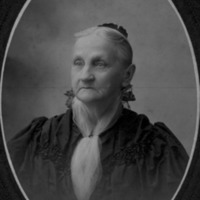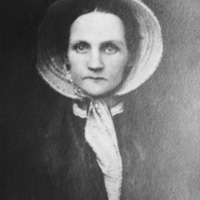Mary Tenney Castle
Title
Mary Tenney Castle
Subject
Missionaries
Biographies
Hawaii
Cemeteries
Mary Tenney Castle
Biographies
Hawaii
Cemeteries
Mary Tenney Castle
Description
Mary Tenney Castle (October 26, 1819 - March 13, 1907)
Philanthropy, education and religion were the interests that drove Mary Tenney Castle’s life; that she carried out her work in those fields in the Hawaiian Islands was a fate decided by her elder sister, Angeline Tenney Castle.
Mary became the second wife of Samuel Northrup Castle, a member of the Hawaiian Islands Mission who arrived in Hawaii with the eighth company of missionaries in April of 1837 aboard the ship Mary Frazier. He was accompanied by Angeline, who lived until 1841.
When Samuel Castle returned to the United States in search of a new wife, it was Mary, his wife’s sister, that he chose. Mary’s honest assessment of herself as a Christian, saying that she would continue to question both her own religious view and that held within the spiritual foundation of the mission, made some on the American Board of Commissioners for Foreign Missions (ABCFM) question her fitness for the role of Samuel’s wife. The ABCFM gave the marriage a vote of confidence and she arrived in the islands in March 1843. She became the stepmother and aunt to Angeline and Samuels’s daughter Mary, and went on to have ten children more. When the ABCFM ceased the support of the Hawaiian Mission, Samuel joined forces with Amos Cooke, a missionary, and the two formed Castle and Cooke, a mercantile business.
Samuel Northrup was not a missionary but a secular agent to the mission, one who had daily contact and correspondence with the mission stations. This situation created space for his wife Mary to pursue her interests, and within a short time her home became a meeting place for those interested in education of all types. Mary’s own education was considered radical at the time. She studied at the Deerfield Academy and was influenced by the popular movements of the time which opposed slavery and alcohol and supported women’s suffrage and prison reform. When Samuel died in 1894, Mary created the Samuel Northrup Castle Benevolent Trust which, under the name Samuel N. And Mary Castle Foundation, continues to serve the people of Hawaiʻi today.
Mary Tenney Castle
Born October 26, 1819 Plainfield, New York.
Died March 13, 1907 Honolulu, Hawaii
Sources:
Notable Women of Hawaii, Barbara Bennett Peterson,ed., University of Hawaii Press 1984
Partners in Change, David Forbes, Ralph Kam, Thomas Woods, editors; Hawaiian Mission Children’s Society, 2018
A Century of Philanthropy:A History of the Samuel N. and Mary Tenney Castle Foundation, Alfred L. Castle, Hawaiian Historical Society, 2001
Philanthropy, education and religion were the interests that drove Mary Tenney Castle’s life; that she carried out her work in those fields in the Hawaiian Islands was a fate decided by her elder sister, Angeline Tenney Castle.
Mary became the second wife of Samuel Northrup Castle, a member of the Hawaiian Islands Mission who arrived in Hawaii with the eighth company of missionaries in April of 1837 aboard the ship Mary Frazier. He was accompanied by Angeline, who lived until 1841.
When Samuel Castle returned to the United States in search of a new wife, it was Mary, his wife’s sister, that he chose. Mary’s honest assessment of herself as a Christian, saying that she would continue to question both her own religious view and that held within the spiritual foundation of the mission, made some on the American Board of Commissioners for Foreign Missions (ABCFM) question her fitness for the role of Samuel’s wife. The ABCFM gave the marriage a vote of confidence and she arrived in the islands in March 1843. She became the stepmother and aunt to Angeline and Samuels’s daughter Mary, and went on to have ten children more. When the ABCFM ceased the support of the Hawaiian Mission, Samuel joined forces with Amos Cooke, a missionary, and the two formed Castle and Cooke, a mercantile business.
Samuel Northrup was not a missionary but a secular agent to the mission, one who had daily contact and correspondence with the mission stations. This situation created space for his wife Mary to pursue her interests, and within a short time her home became a meeting place for those interested in education of all types. Mary’s own education was considered radical at the time. She studied at the Deerfield Academy and was influenced by the popular movements of the time which opposed slavery and alcohol and supported women’s suffrage and prison reform. When Samuel died in 1894, Mary created the Samuel Northrup Castle Benevolent Trust which, under the name Samuel N. And Mary Castle Foundation, continues to serve the people of Hawaiʻi today.
Mary Tenney Castle
Born October 26, 1819 Plainfield, New York.
Died March 13, 1907 Honolulu, Hawaii
Sources:
Notable Women of Hawaii, Barbara Bennett Peterson,ed., University of Hawaii Press 1984
Partners in Change, David Forbes, Ralph Kam, Thomas Woods, editors; Hawaiian Mission Children’s Society, 2018
A Century of Philanthropy:A History of the Samuel N. and Mary Tenney Castle Foundation, Alfred L. Castle, Hawaiian Historical Society, 2001
Publisher
Hawaiian Mission Children's Society Library (HMCSL), located on the campus of the Hawaiian Mission Houses Historic Site and Archives
Rights
This material is for reference only. If you would like permission to publish or reproduce this material, please send your requests to [email protected]
Format
text, jpeg, QR code
Type
text
Identifier
https://hmha.missionhouses.org/items/show/14050
Citation
“Mary Tenney Castle,” Hawaiian Mission Houses Digital Archive, accessed November 28, 2024, https://227924.t67moptb6.asia/items/show/14050.


